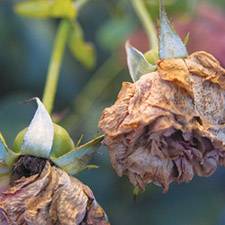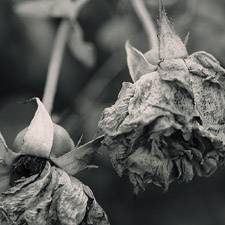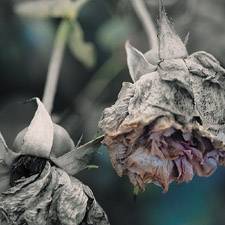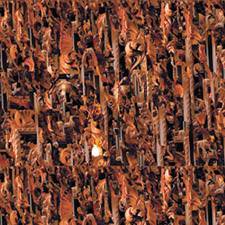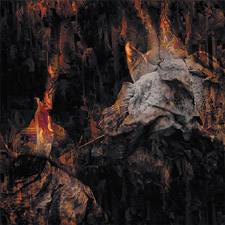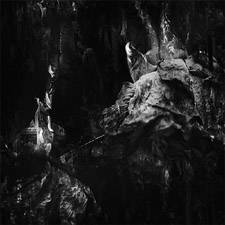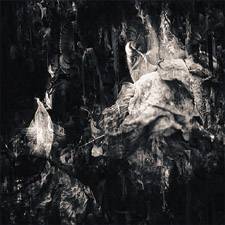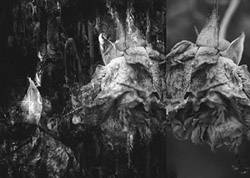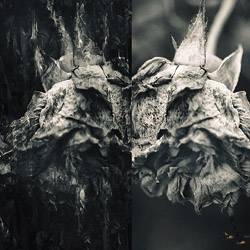Building the Image
| I started with the Dried Roses photo. I wanted to crop them to emphasize the detail and texture, without objectifying one flower as the central subject. After opening the image, I used the Crop tool to reduce it to a square and tweaked the contrast a bit with Curves: I applied a standard S-curve with the curve points of Input: 53, Output: 59, and Input: 185, Output: 205. This adjustment lightened the image overall, bumping up the contrast and bringing out a hint of detail in the shadow areas (see Figure
Adding Gradient MapsFrom here on in for the development of the final image, I played with a series of tonal adjustments using Gradient Maps and Curves and added a complex pattern for good measure. As you look back at the result of this design, you may ask why I used three Gradient Map and two Curves adjustment layers when I might have been able to do everything with just one or two adjustment layers. The key thing to understand is that, at the time, I wasn't sure what the final result was going to be; with such subtle gradations of tone, I needed to work in small increments. Small variations of tone and lots of adjustment layers gave me full flexibility to make subtle revisions. The first gradient map (the Gradient Map 1 layer) reduced the highlights to pink and left the shadows black. Instead of mapping to white, I mapped the highlights to a peach color with the RGB values of R198, G183, B157. (You'll soon see that I copied and pasted this black-to-pink gradient two more times.) After creating the adjustment layer, I added a layer mask and painted on the layer mask with a soft gray brush to let some of the underlying layer's color show through, including the bottom of the flower and the background (see Figures
Then I selected the Gradient Map 1 layer and dragged it to the New Layer icon in the Layers palette to duplicate the layer (this action automatically named the new layer Gradient Map Copy 2). I then dragged the mask icon from this duplicated layer to the trash to delete the mask from the duplicate layer. This action darkened the image even further. Using Pattern MakerAs I was working with the evocative romanticism of the rose imagery, I was reminded of the illuminated scrollwork from the photo I shot at a frame shop in Florence. Pattern Maker is a Photoshop filter that generates random patterned tiles from rectangular images or selections. The results of this filter are seamless tiles that are evocative of their original sources, while presenting a geometric abstraction that recalls the cubist paintings of Braque and Picasso. In this instance, I was trying to create a pattern that captured the light and shadow of the original photo, along with the flowing scrollwork from the frame sections. I opened the Frame Shop photo and selected a vertical marquee portion of the scrollwork area to serve as the source I would use to generate a pattern using the Pattern Maker filter. I copied the selection and launched the Pattern Maker dialog box (Filter, Pattern Maker). I selected the Use Clipboard as Sample option in the Tile Generation section and clicked the Generate and Generate Again buttons to create a series of repeating pattern tiles. I scrolled through the Tile History viewer to select the pattern I was after and clicked OK to apply the pattern (Note: The tile generator in Pattern Maker is random and nonrepeatable. Do not expect to re-create the exact same tile result.) I copied and pasted the repeating pattern into the composite and closed the source image without saving it (see Figure
I repositioned the pattern layer within the composite, dragging the new layer with the Move tool. To position the layer, I started by lowering the opacity to get a sense of how the graphic elements would align with the rest of the composition. When I was satisfied with its location, I set the opacity back to 100% and began to apply blending modes to integrate it with the lower rose layers. I set the blending mode in the Layers palette for the Frames Pattern layer to Overlay, which combined the pattern with the darker areas quite nicelyalthough it was at the expense of all of that rose detail I had just labored over. To bring the rose back, I added a layer mask and painted the mask to hide the pattern in the center, letting the rose show through (see Figure
More Tone AdjustmentsWith the blended pattern in place, I decided that any presence of color was going to work against the shadowy black shadow areas I had been developing. To reduce the color further, I added a couple more tone adjustment layers to desaturate the image and add contrast. The first adjustment layer was another gradient map layer, which I created by copying the Gradient Map 1 layer a third time and dragging it above the Frames Pattern layer in the layer stack. This new layer was automatically named Gradient Map 1 Copy 3. You may wonder why I would add a gradient map layer on top of an existing gradient map layer, considering that the color-stop selections of the top gradient map would overwrite the color selections of the gradient maps beneath it in the stack. At first glance, the topmost gradient map in the layer stack appears to cancel out the lower ones. Although the color information is indeed lost, the tonality of the lower gradient maps show through, thus allowing deep controls for contrast and tonal range. Although the shadows were getting more subtle and evocative with this newest gradient map adjustment, the highlights suffered, so I added a Curves adjustment layer, with data points set to Input: 30, Output: 46, and Input: 112, Output: 235. I named this layer Curves 1, and it did a nice job of opening up the highlight areas and bringing back some of the details that were lost in the shadows (see Figure
Copy MergedI chose Select, All to select the entire image and Edit, Copy Merged, to copy the composite. I pasted the result at the top of the layer stack and named the layer Copy Merge, Dodge, Mask. I then selected the Dodge tool with a 300-pixel brush and dodged around the main rose area to lighten the center of the image. Because the Dodge tool modifies only a single layer at a time, I had to use the Copy Merged command to reduce the composite to a single layer. Then I added a layer mask to the Copy Merge, Dodge Mask layer and masked out the outer edges and lower-right corner so that the lower areas showed through in these spots. The new mask allowed the lightened copy/merge layer to show through in the center, while the darker edges of the image remained intact (see Figure
Adding a Mirror ImageIn an effort to extend the image beyond its current boundaries, I added 675 pixels of extra canvas to the right side of the image. I then drew a rectangular selection around the main rose image in the composite and turned off visibility for all layers except the Dried Roses, Gradient Map 1, and Gradient Map 1 Copy 2 layers. This action eliminated almost all the abstract patterning and presented more of a clear photographic rendering of the rose. I chose Edit, Copy Merged to duplicate the visible layers and then pasted them into the composite above the Copy Merge, Dodge, Mask layer. Holding down the Shift key, I dragged the new image layer into the space where I had created the new canvas (the Shift key constrained my movement to the horizontal direction, maintaining vertical alignment). By choosing Edit, Transform, Flip Horizontal, I flipped the pasted image to create a mirror image, and named the layer Mirror Image (see Figure
Cropping and LighteningAt this point, I figured out what this image was about. I had the predominant rose image on the right side serving as the central image, while the darker, more ominous mirror image on the left provided an evocative counterpart. The remaining areas on the far left were superfluous and distracting. I selected the Crop tool, pressed the Shift key, and drew a new square crop shape around the mirrored images, excluding the ancillary information on the left. I double-clicked within the crop area to apply it. To complete the design, I made one last adjustment: There was a bright swirl pattern from the Frames Pattern layer on the left side, just above the rose area. It was so bright and distinctive that it was distracting from the sensuous rose-petal detail just beneath it. I added one last layer called Swirl Adjustment, just above the Mirror Image layer, by clicking the New Layer icon in the Layers palette. I then chose the Clone Stamp tool, set Opacity to 68%, enabled the Sample All Layers check box, and selected a 147-pixel brush. I Option-clicked (Alt-clicked in Windows) in the shadows to set the reference point, and painted over the swirl area to mask the brightness and deemphasize the patterned area. After pulling some test proofs, I decided that the overall contrast was too low, and that the shadows were filling in too much. To address this problem, I added one final Curves adjustment layer to the top of the layer stack with data points set to Input: 38, Output: 53, and Input: 169, Output: 219 to complete the image (see Figure
|
EAN: 2147483647
Pages: 141
